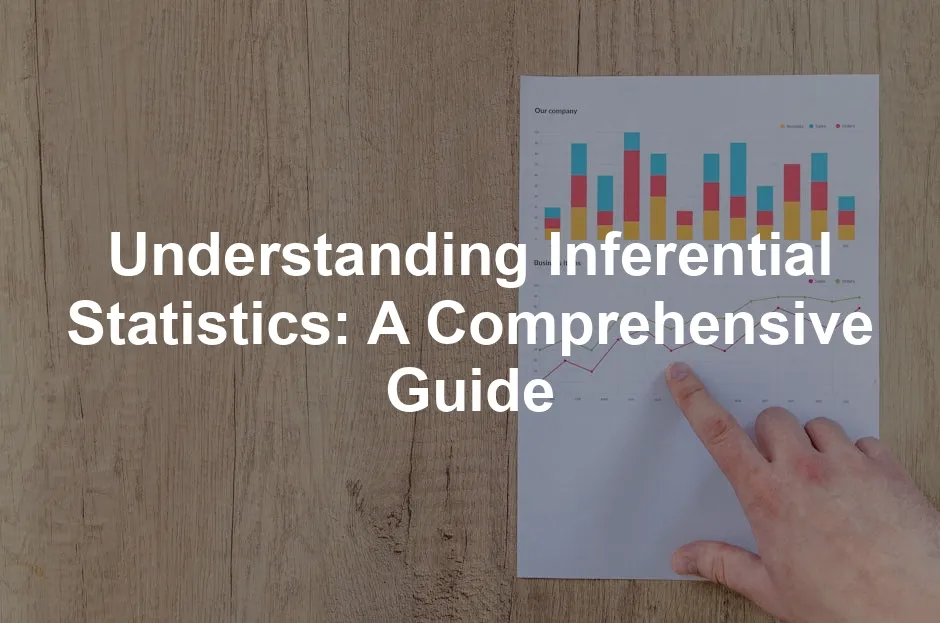Introduction
Have you ever wondered how researchers make predictions about large populations from small samples? That’s where inferential statistics comes in. It’s a powerful tool in data analysis, helping us make educated guesses and generalizations based on sample data. Unlike descriptive statistics, which merely summarizes data, inferential statistics allows us to infer characteristics of a larger group.
If you’re looking to dive deeper into the world of statistics, consider picking up “The Art of Statistics: Learning from Data” by David Spiegelhalter. This book will unravel the mysteries of data interpretation while keeping you entertained with its witty insights!
Summary and Overview
Inferential statistics is the art of drawing conclusions about populations from sample data. This technique is vital in fields like social sciences, business, and healthcare. By utilizing methods such as hypothesis testing, confidence intervals, and regression analysis, we can make significant predictions. Remember, the accuracy of these inferences greatly relies on sample size and variability. The larger and more representative the sample, the more reliable the conclusions.

Understanding the role of hypothesis testing is crucial for making informed predictions in various fields. statistics hypothesis testing cheat sheet
What is Inferential Statistics?
Inferential statistics is a branch of statistics focused on making inferences about populations based on samples. The purpose is straightforward: analyze sample data to understand population characteristics.
First, let’s clarify some key concepts:
- Population vs. Sample: The population is the entire group of interest, while a sample is a subset of that group.
- Parameter vs. Statistic: A parameter refers to a characteristic of the population, while a statistic describes a sample.
- Sampling Distribution: This is the distribution of a statistic over many samples drawn from the same population.
Understanding these concepts is crucial for making accurate inferences. They help us grasp how sample data can reflect broader population trends.
So, how does inferential statistics apply to you? Consider how it might help in your field, whether you’re in marketing, healthcare, or education. Reflect on the ways you could leverage sample data to make informed decisions.

Key Concepts in Inferential Statistics
Population and Sample
In inferential statistics, we often work with two important concepts: population and sample. The population refers to the entire group we’re interested in studying, while a sample is a subset of that population. Understanding the difference is crucial. Why? Because inferential statistics relies on analyzing samples to make conclusions about populations.
Representative sampling is vital. When your sample reflects the population accurately, your conclusions are more reliable. Imagine trying to predict a city’s voting behavior by only surveying one neighborhood. It wouldn’t give you the full picture, right?
Several sampling methods can help ensure representation. Some common methods include:
- Simple Random Sampling: Every member has an equal chance of selection.
- Stratified Sampling: The population is divided into subgroups, and samples are drawn from each.
- Cluster Sampling: Entire groups are selected randomly.
These approaches minimize bias and improve the quality of your inferences. For a deeper understanding of stratified sampling, you can refer to this guide on stratified sampling.

Understanding stratified sampling can enhance your ability to draw accurate conclusions from your data. stratified sampling
Hypothesis Testing
Hypothesis testing is at the core of inferential statistics. This process helps us determine whether there is enough evidence to support a specific claim about a population.
It starts with two hypotheses: the null hypothesis (H0) and the alternative hypothesis (H1). The null hypothesis often states there’s no effect or difference, while the alternative suggests otherwise. For example, if we’re testing a new drug’s effectiveness, H0 might state that it has no effect on recovery time.
A critical aspect of hypothesis testing is the significance level (alpha). This threshold helps to decide whether to reject H0. Commonly, alpha is set at 0.05, indicating a 5% risk of concluding that a difference exists when there isn’t one—a Type I error. Conversely, failing to reject H0 when it’s false is a Type II error.
- t-tests: These compare the means of two groups.
- ANOVA (Analysis of Variance): This compares means across three or more groups.
Hypothesis testing is essential in research, allowing us to make informed decisions based on sample data. If you’re keen on diving deeper into hypothesis testing, grab a copy of “Naked Statistics: Stripping the Dread from the Data” by Charles Wheelan. It’s a fun read that makes statistics less intimidating!

Confidence Intervals
Confidence intervals provide a range of values that estimate a population parameter. They express the uncertainty around sample statistics, giving insight into how close our sample estimate is to the actual population parameter.
A confidence level, often set at 95%, indicates how confident we are that the population parameter lies within the interval. For example, if we calculate a 95% confidence interval for the average height of students in a school as [160 cm, 170 cm], we can say we are 95% confident that the true average height falls within this range.
Calculating a confidence interval involves determining the margin of error, which accounts for variability in the sample. The formula typically includes the standard deviation and the sample size.
In real-world scenarios, confidence intervals are invaluable. They assist in interpreting survey results, clinical trials, and market research. By providing a range, they offer a clearer picture of what the data suggests about the population, rather than a single point estimate. For those looking to sharpen their skills in data analysis, consider picking up “Statistics for Dummies” by Deborah J. Rumsey. It’s a fantastic resource for beginners!

Differences Between Descriptive and Inferential Statistics
To understand the differences between descriptive and inferential statistics, consider the following table:
- Purpose: Summarizes data characteristics vs. Makes predictions about populations based on sample data
- Focus: Analyzes specific datasets vs. Generalizes findings to larger populations
- Examples: Mean, median, mode, standard deviation vs. Hypothesis testing, regression analysis, confidence intervals
- Application: Helps understand and visualize data vs. Tests hypotheses and draws conclusions
- Sample Size Requirement: Can analyze any size dataset vs. Requires sufficient sample size for accurate inferences
- Generalizability: No predictions beyond the sample vs. Allows predictions about the population
Descriptive statistics simply summarize data, while inferential statistics enable predictions and generalizations about larger groups. For a more in-depth look at descriptive statistics, you can explore descriptive statistics in manufacturing plant.

Understanding descriptive statistics is essential for interpreting data effectively. descriptive statistics in manufacturing plant
Practical Applications of Inferential Statistics
Inferential statistics plays a crucial role in various fields. It’s not just about crunching numbers; it influences decisions that affect our daily lives. Let’s explore a few key areas where inferential statistics shines.

Healthcare
In healthcare, inferential statistics helps determine treatment effectiveness. For instance, a clinical trial may use a sample of patients to test a new medication. Researchers analyze the results to infer the drug’s likely effectiveness in the broader population. One notable example involved testing a new vaccine. By reviewing data from thousands of participants, researchers could predict how well it would work for the general public. For more insights on healthcare applications, check out the best statistical techniques from university of minnesota for healthcare applications.

Healthcare applications of inferential statistics are essential for improving treatment outcomes. best statistical techniques from university of minnesota for healthcare applications
Marketing
Marketers rely on inferential statistics to understand consumer behavior. Through surveys and focus groups, they gather sample data to make predictions about market trends. For example, a company might survey 1,000 consumers to gauge interest in a new product. The results help them decide whether to launch the product nationwide. To get a better grip on the data analysis side, consider reading “Data Science for Business” by Foster Provost and Tom Fawcett. It’s a great resource for marketers!

Social Sciences
In social sciences, inferential statistics helps researchers draw conclusions about societal trends. For instance, a political analyst might use survey data to predict election outcomes. By analyzing a sample of voters, they can estimate how the entire electorate will behave. This method was used during recent elections to forecast voting patterns based on demographic data.

Education
Inferential statistics is also vital in education. Schools often conduct assessments on a sample of students to evaluate teaching methods. By analyzing test scores, educators can infer which methods are most effective across the entire student body. This approach helps in refining curricula and improving educational outcomes. For those teaching statistics, consider using “Practical Statistics for Data Scientists” by Peter Bruce and Andrew Bruce. It’s a practical guide that can enhance your teaching!

Case Study: Public Health Initiatives
Consider a public health initiative aimed at reducing smoking rates. Researchers might collect data from a diverse sample of the population. By applying inferential statistics, they can determine the program’s overall impact on smoking habits. The findings guide policymakers in implementing more effective health strategies.

Conclusion
Inferential statistics is a powerful tool that shapes decisions across various sectors. By analyzing sample data, we can make informed predictions about larger populations. This approach is essential in healthcare, marketing, social sciences, and education. Its ability to influence real-world decisions highlights the need for accurate sampling and analysis.
Inferential statistics is fundamental in understanding and analyzing data. It enables us to make predictions about populations based on sample information. This process is vital for informed decision-making in various fields. However, careful sampling is crucial to ensure valid inferences. Poor sampling can lead to misleading conclusions. If you’re looking for a solid reference on statistical methods, consider “Statistical Methods for the Social Sciences” by Alan Agresti and Barbara Finlay. A classic that every statistician should have!

As you navigate the world of data, remember that inferential statistics provides the framework for drawing meaningful insights. Its applications are vast, impacting everything from healthcare to marketing. If you’re intrigued, consider exploring more about inferential statistics to enhance your analytical skills. Embrace the opportunity to apply inferential statistics in your field, and you’ll be well-equipped to make data-driven decisions.
FAQs
What is the main purpose of inferential statistics?
The main purpose of inferential statistics is to draw conclusions about a larger population based on sample data. It allows researchers to make predictions and generalizations, which helps in decision-making across various fields.
How does hypothesis testing work?
Hypothesis testing starts with formulating a null hypothesis, usually stating no effect or difference. Researchers collect sample data and use statistical tests to determine if there’s enough evidence to reject the null hypothesis. If the evidence is strong, the alternative hypothesis is supported.
What are confidence intervals?
Confidence intervals are ranges of values that estimate the true population parameter. They provide a measure of uncertainty around a sample statistic. For example, a 95% confidence interval means there’s a 95% chance that the population parameter lies within that range.
What is the difference between a parameter and a statistic?
A parameter describes a characteristic of a population, such as the population mean or variance. In contrast, a statistic describes a characteristic of a sample, like the sample mean. Parameters are often unknown, while statistics are calculated from data.
Why is sample size important in inferential statistics?
Sample size plays a crucial role in inferential statistics. Larger sample sizes generally lead to more reliable inferences by reducing variability. A well-sized sample can better represent the population, leading to more accurate conclusions and predictions.
Please let us know what you think about our content by leaving a comment down below!
Thank you for reading till here 🙂
All images from Pexels




